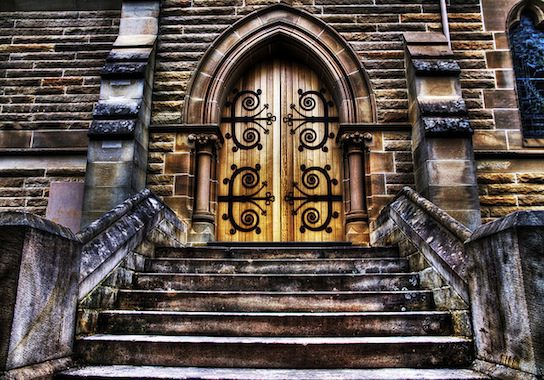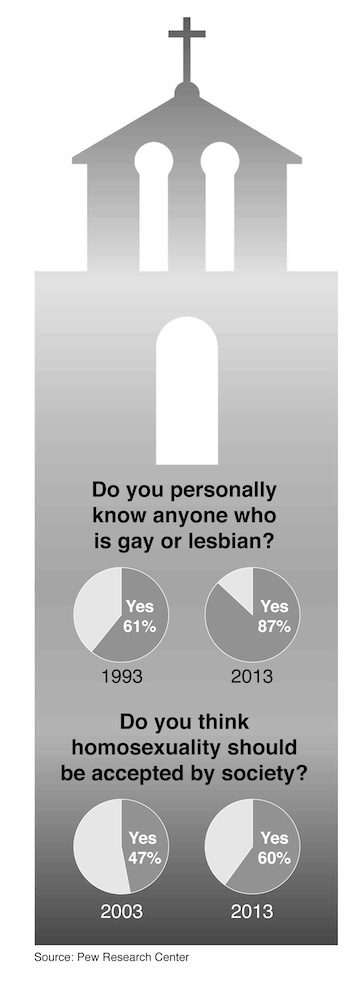Coming Out Christian

Coming out of the closet is the simplest tool of the gay movement, yet it’s proven to be the most powerful and even the most spiritually profound. On the political side, Pew Research data this year found that knowing someone who is gay was the most common reason people switched to supporting gay marriage, and the percentage of people who know someone openly gay has risen over 25 points since 1993.
But on a more personal level, coming out is a practice of honesty and integrity—no more “pronoun games,” no more hedging and sudden silence when the conversation turns to romance or visions of one’s future. The coming-out narrative transforms a source of shame and stigma into a freely accepted, simple truth, which no longer excludes one from the ordinary social world. Coming out allows deeper bonds to be formed: not only romantic relationships but deeper friendships, more honest familial ties, and more pointed and relevant relationships with spiritual guides such as confessors or pastors.
As the gay movement has enjoyed remarkable success, a new kind of coming out is occurring, in which gay or same-sex attracted Christians openly discuss both our sexual orientation and our desire to live according to the historic teaching of the Christian church, which bars sexual activity outside marriage of one man and one woman. As gay Christians—an unavoidably reductive term—come out, our presence is changing the culture of our churches.
When I became Catholic, in 1998, I didn’t know of a single other openly gay Christian who intended to follow Church teaching on sexuality. I made my way through what appeared to be a trackless wilderness armed with good friends, cheap vodka, and hubris. Nowadays an undergraduate in my circumstances could simply Google and find scores of websites with names like Odd Man Out and Sexual Authenticity. The blog Spiritual Friendship brings together a relatively wide range of writers with different sexual orientations, vocations, and church affiliations. (I’m a contributor there.) Those online communities have led to many real-life connections: it seems like every week I see somebody on Facebook posting about his road trip to meet other gay Christians.
Openly gay or same-sex attracted authors like Wesley Hill, Melinda Selmys, Ron Belgau, Daniel Mattson, Aaron Taylor, and Joshua Gonnerman write regularly for religious journals like First Things and Christianity Today. Our perspectives—and our disagreements with one another—are becoming part of ordinary public Christianity.
In July, Christianity magazine profiled three British “evangelical church leaders who experience same-sex attraction,” all of whom used real names and photos. Over the summer, in an uncoordinated movement that reflects a rapidly changing culture, several bloggers who had used pseudonyms began to use their real names instead. Homosexuality is being transformed from a faceless, shadowy problem “out there” to an umbrella term for a wide range of experiences that affect ordinary people you might pass on the street or pass the peace to in church.
Many celibate gay Christians have found support from their friends and church communities—although acceptance can take a long time.
Matt Jones, who blogs at MatthewFranklinJones.com, told me the poignant story of his pastor’s gradual shift from pushing orientation change as the only possible hope for gay Christians to encouraging Jones to come out to the pastoral staff at their church. This coming out led to Jones losing his church internship and a series of painful meetings in which Jones was told, among other things, that he was “a barrier to the gospel” and that he needed to speak and dress more masculinely. The pastor continued to support him, though, and eventually managed to turn the church away from the belief that same-sex attraction is sinful in itself. These are small steps forward that would not have happened without Jones’s openness.
I spoke with two young Christians whose nondenominational church had gained something of a reputation as a haven for gay people. Mary and Thor asked that I use their first names—Mary is not yet out to her extended family and Thor was concerned about being Googled by potential employers—but they had been open enough within their church that they ended up speaking on a panel entirely made up of gay or same-sex-attracted members of the congregation.
When Thor began to realize that he was gay, in eighth grade, he remembers thinking, “‘Oh, I guess it is true that God hates me, that God is against me.’ I was really heartbroken.” As an adult, he found a small group at his church that took him in after a grueling period working overseas. The leaders of the group provided a safe, encouraging place for him to explain what he was feeling and eventually invited him to talk to a group of college students. “I think that really changed the culture in our church,” he noted. “People started coming out of the woodwork to talk to me.”
The changes in the church were gradual, but dramatic. People in gay relationships began to come to the church because it was a place where they could bring their questions about faith without having to hide their relationship with their partner. This posed a lot of challenges, but Thor says, “I think what made it work in that church is that there was no double standard. There are churches that give lip service to addressing issues in the straight community, but this is a church that was very serious about the sexual brokenness of their straight members. It’s always gonna be messy; but in every church there are straight people who are living together before they’re married and lots of other stuff.”
 “I think if there’s no homosexual couples going to your church that’s probably a bad sign,” he adds. “You’re probably not having a reputation for actually being Jesus.”
“I think if there’s no homosexual couples going to your church that’s probably a bad sign,” he adds. “You’re probably not having a reputation for actually being Jesus.”
Thor hopes that churches will continue to change and that the openness he experienced at Midtown will be extended to kids going through what his eighth-grade self suffered.
“I would want kids who grew up in the church to not first deal with this when they went away to college,” he says, “but in their middle-school and high-school youth groups, to be honest about this with people. I was a youth group leader and I had seven people confess this to me. I’m thankful that I got to be at least the first voice that they got to process this with, that the church had a chance to do its version of the story before they only heard the other version.”
♦♦♦
Mary and Thor’s stories show the most obvious and public kinds of change, in which more gay Christians come out. But our openness also creates deeper, less obvious changes within our churches. I’m seeing three kinds of slow, big-picture change within Christian communities. None of these are about working out the theology better, or coming up with more sensitive or persuasive rhetoric. More thoughtful, personal, and culturally relevant theology in this area would doubtless be helpful, but what people most yearn for is a vision of what their futures might look like.
The first change is a shift away from the “ex-gay narrative.” Although Thor found a lot of love and support in Exodus International, one of the pillars of the ex-gay movement, it closed in June. Its president, Alan Chambers, formally apologized for its focus on orientation change and the hurt this had caused over the years. Some people with ties to the ex-gay movement have been honest and realistic about their experiences with ongoing same-sex attraction—Julie Rodgers, who blogs at Spiritual Friendship, is a great example—but in general the movement has tended to invoke Freudian psychology and set a goal of orientation change. For years the ex-gay movement has acknowledged that orientation change is a minority experience, but that acknowledgment never seemed to shift their overall emphasis.
Today, Christians who begin to realize they’re gay—or, in a great Onion headline that captures my freshman and sophomore years of college pretty well, “Gay Teen Worried He Might Be Christian”—have options beyond tweezering at their relationships with their fathers and praying for change.
Gay Christians may end up married to the opposite sex, because life and sexuality are complex: Spiritual Friendship has a few married contributors, although none consider themselves “ex-gay.” But most gay Christians who accept the historical teaching are accepting a lifetime of celibacy. We can’t plan on marriage or wait around for it. So we’ve had to be much more intentional about asking how we can give and receive love. To whom can we devote ourselves, and on whom can we rely?
In order to help answer these urgent questions, some churches and individual Christians are rediscovering a broader understanding of “kinship” that goes against a culture in which marriage is the only chosen form of adult kinship we recognize. In the Gospel of Mark, Jesus promises that those who lose their homes or families for His sake will receive new homes and families, “a hundred times more now.”
But the church has rarely deigned to provide that family for its gay members who are estranged from their families of origin, or who suffer from loneliness and lack of purpose because they’re unmarried and unable to pursue marriage. Gay Christians are finding “chosen families” in many different ways. Some live in intentional communities: in my forthcoming book I interview a man who has found that community life offers him the kind of lasting, difficult love that chastens and rewards us. Others look to the nearly forgotten Christian traditions in which friendship was treated as a form of kinship that carried obligations of care.
Alan Bray’s 2003 study The Friend explores these traditions, in which friends and godparents became part of an extended family; many of my gay Christian friends have found it immensely healing to be welcomed into a family home by their friends. Matt Jones, describing his participation in a friend’s wedding, has blogged: “After I came out to the groom, he sent me a letter explaining how, even should I never have a family of my own, I had to know that I would always be a part of theirs—that I was someone they wanted their kids to know and learn from. They have demonstrated that their love for each other somehow includes me.”
Brent Bailey, who blogs at Odd Man Out, suggests that celibate gay Christians can offer witness to their heterosexual comrades. He says that the evangelical culture in which he grew up often made it seem like “maintaining healthy nuclear families is our primary calling as Christians.” Yet there were no limits beyond the basic abstinence-until-marriage, ring-by-spring norms.
“When you get married [Christian communities often act as if] there are essentially no boundaries to sexual expression with your partner (including contraception and various sexual practices),” he noted in an email, and the dating culture was basically the same as that of the secular culture, “except maybe you try not to go too far physically until you’ve tied the knot.” He suggests that the witness of gay Christians may challenge all of these concessions to the mainstream culture: “Now that we as a culture understand that gay people exist, I think the willingness of certain gays to submit to the sexual ethics of any given church are reminding churches that, oh yeah, we do have sexual ethics for good reasons, and sometimes those ethics are pretty intense, and we can’t just expect gay people to uphold them.”
This brings us to the third change, in which some churches are beginning to rediscover the least American feature of Christianity: the Cross. The sentimental, Disney view of marriage was always wrong. Marriage changes our loneliness but rarely cures it. There’s a reason the final section of Sigrid Undset’s great novel of marriage, Kristin Lavransdatter, is entitled “The Cross.”
But for a long time American Christianity has sought to fix loneliness and suffering rather than accepting them as part of the core of Christian experience. We’re a prosperity-gospel, “Go out and get that blessing!” people, enthusiastic and hardworking and unwilling to believe that some things can’t be fixed.
Because marriage, the standard American solution to the problem of the human heart, is typically unavailable to gay Christians, we’ve had to confront loneliness earlier and more publicly than many of our peers. 
Wesley Hill’s 2010 book, Washed and Waiting: Reflections on Christian Faithfulness and Homosexuality, has some of the loveliest Christian writing on loneliness I’ve found. And it’s not coincidental that Mary and Thor found their church, which has done so much to welcome gay people, because it was so open in acknowledging the suffering that characterizes many Christian lives.
We’re often ashamed to admit that we suffer. It’s humiliating and it makes us feel like we’re not good enough Christians. This is bizarre since there are very few aspects of Jesus’ own internal life that we know as much about as His suffering. Jesus—unmarried, marginalized, misunderstood, a son and a friend but not a father or spouse—is the preeminent model for gay Christians. In this, as in so many things, we are just like everybody else.
Eve Tushnet blogs at Patheos.com.
Comments